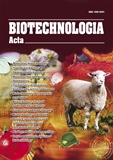ISSN 2410-7751 (Print)
ISSN 2410-776X (Online)

Biotechnologia Acta Т. 18, No. 2, 2025
P. 41-44 , Bibliography 9 , Engl.
UDС 582.66: 602
doi: https://doi.org/10.15407/biotech18.02.041
OBTAINING in vitro CALLUS BIOMASS OF AMARANTH VARIETY “LERA”
K.I. Hutsko, R.O. Petrina
Lviv Polytechnic National University, Ukraine
Aim. To obtain callus biomass of the amaranth variety “Lera” in vitro and determine the optimal concentration of growth regulators in the nutrient medium for maximum callus formation.
Methods. The study was conducted using in vitro cell culture. Cultivation was performed on a modified Murashige-Skoog medium supplemented with benzylaminopurine and naphthylacetic acid at various concentrations. Experimental conditions: photoperiod 16/8 h (light/darkness), temperature 20±1°C, illumination 2000 lux, relative humidity 70%. The total cultivation duration was 56 days.
Results. The seed sterilization method used resulted in a 52% yield of viable explants. Callusogenesis was studied on media containing 3 mg/L BAP in combination with NAA at concentrations ranging from 0.25 to 1.25 mg/L. A total of 61 explants were introduced into each medium. On the 28th day, the explants were subcultured onto a fresh medium of identical composition. The frequency of callus induction was 15–38% on the 28th day and 50–77% on the 56th day, depending on the medium composition.
Conclusions. The optimal medium for obtaining callus culture of the amaranth variety “Lera” is Murashige-Skoog medium supplemented with 3 mg/L BAP and 0.5 mg/L NAA, which provides the highest frequency of callus induction.
Keywords: Amaranthus hypochondriacus, cell culture method, callus biomass, frequency of callus induction.
© Palladin Institute of Biochemistry of the National Academy of Sciences of Ukraine, 2025
References
1. Hadidi, M., Aghababaei, F., Mahfouz,i M., Zhang, W., Julian, McClements D. (2024). Amaranth
proteins: From extraction to application as nanoparticle-based delivery systems for bioactive
compounds. Food chemistry, 439. https://doi.org/10.1016/j.foodchem.2023.138164
2. Xuan, Y., Liu, S., Xie, L., Pan, J. (2023). Establishment of Amaranthus spp. calluses and cell
suspension culture, and the effect of plant growth regulators on total flavonoid content. Tropical
Plants, 2, 15. https://doi.org/10.48130/TP-2023-0015
3. Hutsko, K. I., Petrina, R. O. (2024). Amaranthus as a source of polyphenolic compounds and
flavonoids for use in medicine. Biotechnologia Acta, 17(2), 46–48. https://doi.org/10.15407/
biotech17.02.046
4. Lyubych, V. V., Manzii, O. P., Voitovska, V. I., Klymovych, N. M. (2023). Physicochemical
properties of amaranth grain depending on variety and moisture content. Novitni ahrotekhnolohiyі,
11(1). https://doi.org/10.47414/na.11.1.2023.275736
5. Barba de la Rosa, A. P., de León-Rodríguez, A., Laursen, B., Fomsgaard, I. (2019). Influence of the
growing conditions on the flavonoids and phenolic acids accumulation in amaranth (Amaranthus
hypochondriacus L.) leaves. REVISTA TERRA LATINOAMERICANA, 37(4), 449–457. https://doi.
org/10.28940/terra.v37i4.541
6. Comia-Yebron, R., Aspuria, E. T., Bernardo, E. L. (2017). Callus induction in Аmaranthus tricolor
and Аmaranthus spinosus. Journal of the International Society for Southeast Asian Agricultural
Sciences, 23, 12–23.
7. Zagorodnya, D. S., Hutsko, K. I., Petrina, R. O. (2021). Investigation of the influence of
growth regulators on the growth of callula biomass Carlina acaulis. Vcheni zapysky TNU imeni
V.I. Vernadskoho. Seriya: Tekhnichni nauky, 6(71), 161–166. https://doi.org/10.32838/2663-
5941/2021.6/26

